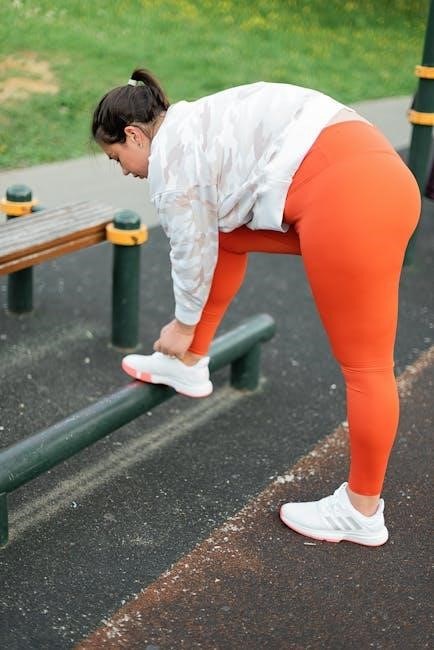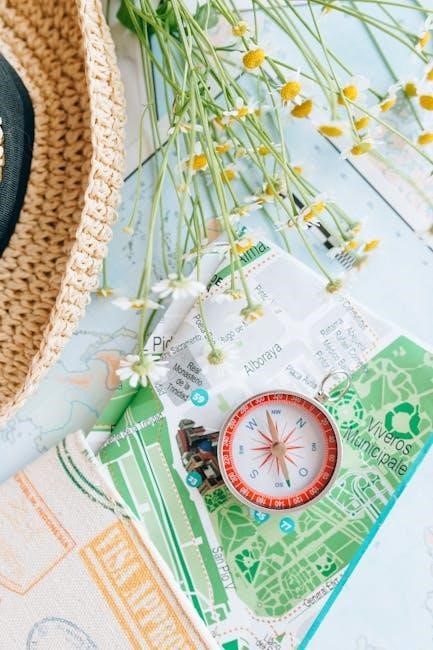Choosing the right shoelace length is crucial for comfort‚ support‚ and style․ This guide helps you determine the perfect fit based on shoe type‚ eyelets‚ and usage․ Learn how to measure‚ avoid common mistakes‚ and explore material options for optimal performance and durability․ Discover tips for replacing laces and teaching kids to tie them effectively․ Whether for casual‚ athletic‚ or specialty shoes‚ this guide ensures you find the ideal shoelace length every time․
1․1 Why Shoelace Length Matters
Proper shoelace length ensures a secure fit‚ optimal performance‚ and comfort․ A lace that’s too short may not stay tied‚ while one that’s too long can be bulky or get in the way․ Correct length supports foot stability‚ prevents blisters‚ and enhances shoe functionality․ It also makes tying easier‚ especially for children learning to lace their shoes․ The right length balances practicality and style‚ ensuring your shoes look and feel their best․
1․2 Brief Overview of Shoelace Sizing
Shoelace sizing is determined by factors like shoe type‚ eyelet count‚ and intended use․ Generally‚ more eyelets require longer laces․ Casual shoes may need shorter laces‚ while athletic shoes demand longer ones for better support․ Measuring existing laces or using size charts can help find the perfect fit․ Proper sizing ensures comfort‚ stability‚ and ease of tying‚ making it essential for both functionality and style․
Factors Determining Shoelace Size
Shoelace size is influenced by shoe design‚ eyelet count‚ and intended use․ More eyelets require longer laces‚ while casual shoes may need shorter ones for a snug fit․
2․1 Shoe Type and Design
Different shoe types require varying lace lengths due to their design․ Sneakers and casual shoes often need shorter laces‚ while boots and formal shoes may require longer ones․ The number of eyelets‚ spacing‚ and tightness preferences also influence the ideal length․ For example‚ hiking boots with more eyelets need longer laces for secure lacing․ Always consider the shoe’s specific features to ensure proper fit and comfort․
2․2 Number of Eyelets
The number of eyelets on a shoe directly impacts the required shoelace length․ Shoes with fewer eyelets‚ such as 3-4‚ typically need shorter laces‚ while those with 9-11 eyelets require longer ones․ Each additional eyelet adds to the total lace length needed for proper lacing․ This ensures the laces are neither too tight nor too loose‚ providing a comfortable and secure fit․ Always count the eyelets to determine the ideal lace length for your shoes․
2․3 Intended Use (Casual‚ Athletic‚ etc․)
The intended use of shoes significantly influences the required shoelace length․ Athletic shoes‚ designed for high-performance activities‚ often need longer laces for secure lacing‚ while casual or formal shoes may require shorter laces for a sleeker look․ The activity level and desired tightness also play a role in determining the ideal lace length․ Always consider the shoe’s purpose to ensure the laces provide the right balance of comfort and support․ This helps in maintaining optimal performance and style for any occasion․

How to Measure Existing Shoelaces
Measure the length and width of your current laces by laying them flat․ Use a ruler to record the length in centimeters and width in millimeters for an accurate fit․
3․1 Step-by-Step Measurement Guide
Lay the shoelace flat on a surface to ensure accuracy․ 2․ Use a ruler to measure the length from tip to tip‚ excluding the aglet․ 3․ Note the length in centimeters․ 4․ Measure the width in millimeters by flattening the lace slightly․ 5․ Record both measurements for reference․ 6․ Compare with a size chart to find the perfect replacement․ Ensure precision for a comfortable and secure fit․
3․2 Using a Shoelace Size Chart
Using a shoelace size chart simplifies finding the perfect fit․ Compare your measured length and width from step 3․1 with the chart․ Align the measurements to determine the ideal size․ Consider the shoe type and intended use‚ as athletic shoes may require longer laces․ Check for brand-specific charts‚ as some vary․ Double-check to avoid sizing errors․ This ensures comfort‚ support‚ and durability‚ making the process quick and accurate for any shoe type․
The Role of Eyelets in Shoelace Length
The number of eyelets on a shoe directly influences the required shoelace length․ More eyelets mean longer laces‚ ensuring proper fit and support․ Count eyelets to determine length accurately for optimal comfort and functionality․ This ensures the laces wrap correctly around the shoe‚ providing the right tension and durability․ Eyelets play a crucial role in achieving the perfect balance between style and performance․
4․1 Calculating Lace Length Based on Eyelets
To determine the ideal lace length‚ count the number of eyelets on your shoe․ Add 2-3 inches for the bow and 1-2 inches per eyelet․ For example‚ shoes with 5 eyelets typically require 36 inches‚ while those with 7 eyelets need 45 inches․ This method ensures proper fit and functionality‚ avoiding laces that are too short or overly long․ Use this formula for accurate measurement and optimal comfort․
4․2 Common Eyelet Configurations
Shoes typically feature eyelet configurations ranging from 3 to 12 eyelets‚ depending on the shoe type․ Sneakers often have 5-7 eyelets‚ while boots may have 9-11 for added support․ Casual shoes usually have 3-5 eyelets‚ ensuring a sleek look․ The number of eyelets directly impacts lace length‚ with more eyelets requiring longer laces․ Common configurations include 5‚ 7‚ and 9 eyelets‚ each suited for different shoe styles and purposes․

Standard Shoelace Length Charts
Standard charts provide general recommendations for lace lengths based on shoe type and eyelets․ Common lengths range from 27″ to 72″‚ ensuring a proper fit for various styles and brands․
5․1 General Size Recommendations
Standard shoelace length charts provide guidelines based on shoe type and eyelets․ For 3-4 eyelets‚ 36″ laces are typical‚ while 9-11 eyelets require 60-72″ laces․ Charts often categorize sizes for sneakers‚ boots‚ and casual shoes‚ ensuring proper fit and functionality․ These recommendations serve as a starting point‚ allowing adjustments based on personal preference or specific shoe designs․ Always refer to brand-specific guidelines for accuracy‚ as variations may exist between manufacturers․
5․2 Variations by Shoe Brand
Different shoe brands often have unique sizing standards for shoelaces․ For example‚ athletic brands like Nike or Adidas may recommend longer laces for their sneakers‚ while brands specializing in boots might offer shorter options․ Some brands provide customizable laces to match specific shoe designs․ Always check the brand’s official guidelines‚ as variations in eyelet configurations and shoe styles can affect the ideal lace length․ This ensures the best fit and performance for your footwear․

Common Mistakes in Choosing Shoelace Size
Overestimating or underestimating lace length and ignoring shoe-specific requirements are frequent errors․ Proper measurement and brand guidelines are essential to avoid poor fit or functionality issues․
6․1 Overestimating or Underestimating Length
Overestimating or underestimating shoelace length is a common mistake․ Too long‚ and laces may drag or cause tripping hazards․ Too short‚ and shoes won’t secure properly‚ leading to discomfort or poor support․ Proper measurement is key․ Use a size chart or measure existing laces to ensure the right fit․ Ignoring these guidelines can result in laces that are impractical or ineffective‚ affecting both functionality and style․ Always double-check before purchasing or replacing laces․
6․2 Ignoring Shoe-Specific Requirements
Ignoring shoe-specific requirements can lead to poor fit and functionality․ Different shoes‚ such as sneakers or boots‚ require laces suited to their design and purpose․ Using laces too short or too long for the shoe type can result in discomfort‚ inadequate support‚ or laces that fray quickly․ Always consider the shoe’s intended use‚ material‚ and eyelet configuration to ensure the laces meet its specific needs for optimal performance and durability․
How to Choose the Right Shoelace Material
Selecting the right material ensures durability and comfort․ Common options include nylon‚ polyester‚ and elastic laces․ Consider factors like water resistance‚ elasticity‚ and style to match your needs․
7․1 Material Types and Durability
Shoelace materials vary in durability and functionality․ Nylon and polyester are popular for their strength and resistance to wear․ Elastic laces offer flexibility‚ ideal for active use․ Cotton laces are soft but less durable․ Consider water-resistant options for outdoor activities․ Durability depends on weave quality and thickness․ Choosing the right material ensures long-lasting performance and comfort‚ catering to specific needs like casual wear‚ sports‚ or specialty uses․
7․2 Matching Lace Color and Style
Choosing the right color and style enhances both functionality and aesthetics․ Opt for laces that match or complement your shoe’s color for a cohesive look․ Consider metallic or neon laces for a bold statement‚ while neutral tones provide versatility․ Patterns and textured materials add uniqueness‚ while classic styles ensure timeless appeal․ Ensure the color aligns with your personal style or shoe design for a polished finish․ This attention to detail elevates your shoe’s overall appearance and ensures a perfect match․
Tips for Replacing Shoelaces
Remove old laces gently to avoid damaging eyelets․ Thread new laces through each eyelet‚ ensuring even tension․ Trim excess lace for a clean finish and secure the ends tightly for durability․
8․1 Removing Old Laces
Gently pull the old laces from the shoe‚ working from one end to the other․ Avoid yanking or forcing‚ which could damage eyelets or stretch the material․ If laces are stuck‚ use a flat tool like a ruler or butter knife to carefully pry them loose․ Once removed‚ inspect and clean the eyelets of any debris to ensure smooth threading of the new laces․ This step ensures a fresh start for your replacement․
8․2 Threading New Laces
Begin by holding the shoe firmly and locate the bottom eyelets․ Insert one end of the new lace through the bottom eyelet on one side‚ then guide it through the corresponding eyelet on the opposite side․ Continue threading the lace upward‚ ensuring it stays centered and untwisted․ For shoes with multiple eyelets‚ alternate sides with each pair to maintain even tension․ Avoid pulling too tightly‚ as this could misalign the laces․ Once reaching the top‚ tie a secure knot to keep the laces in place․
Specialty Shoelaces
Specialty shoelaces offer unique features for specific needs․ Elastic laces provide convenience for quick wear‚ while custom or decorative laces add personalized style․ Both options enhance functionality and aesthetics‚ catering to individual preferences and requirements․
9․1 Elastic vs․ Standard Laces
Elastic shoelaces offer a convenient‚ slip-on design‚ perfect for quick wear and ease of use‚ especially for children or individuals with dexterity challenges․ Standard laces‚ while requiring tying‚ provide precise control over tightness and fit․ Elastic laces are ideal for casual or athletic shoes‚ while standard laces suit formal or performance footwear․ Choose based on your lifestyle and specific shoe requirements for optimal comfort and functionality․
9․2 Custom or Decorative Laces
Custom or decorative shoelaces add a personal touch to your footwear‚ offering unique styles‚ colors‚ and materials․ From vibrant hues to intricate patterns‚ they allow you to express your personality; Made from materials like satin‚ metallic‚ or even glow-in-the-dark yarn‚ these laces can elevate your shoe’s aesthetic․ They’re perfect for special occasions or casual wear‚ providing a creative way to refresh your look without changing the shoes themselves․ Choose designs that complement your footwear for a standout appearance․

How to Teach Kids to Tie Shoelaces
Teach kids to tie shoelaces using simple techniques like the “bunny ear” method․ Use crafts and activities to make learning fun․ Proper lace length makes it easier for them to practice and master the skill‚ building confidence and fine motor skills․
10․1 Basic Tying Techniques
Start with the “bunny ear” method: fold one lace in half‚ tuck the folded end under the other lace‚ and pull tight to form a loop․ Repeat on the other side․ Cross the laces‚ wrap one around the bottom lace‚ and pull through to create a knot․ Practice step-by-step‚ using visual aids or songs to simplify․ Patience and repetition help kids master this essential skill‚ building confidence and fine motor skills․
10․2 Using Shoelace Length for Easier Learning
Using the correct shoelace length simplifies the learning process for kids․ A lace that’s too short can be difficult to manage‚ while one that’s too long may tangle easily․ Opt for laces with a length slightly longer than the shoe’s requirements‚ allowing ample material for easy gripping and manipulation․ This makes it simpler for small hands to create loops and tighten the knot‚ fostering confidence and mastery of the skill․
Proper shoelace size ensures comfort‚ support‚ and style․ Use this guide to find the perfect fit and enjoy optimal performance every time․
11․1 Final Tips for Perfect Fit
Always measure your existing laces or count eyelets to determine the ideal length․ Consider the shoe’s intended use and your personal comfort preferences․ Choose materials that align with your lifestyle‚ whether durability for athletics or style for casual wear․ Refer to size charts for brand-specific recommendations and avoid common mistakes like overestimating or underestimating lace length․ Proper fit ensures optimal performance‚ comfort‚ and longevity of your shoes․
11․2 Importance of Proper Shoelace Size
Proper shoelace size ensures optimal comfort‚ support‚ and performance․ Ill-fitting laces can lead to discomfort‚ poor footwear stability‚ or even tripping hazards․ Correct length prevents laces from being too tight or too loose‚ ensuring proper tension for secure footing․ This is especially crucial for athletic activities‚ where stability is key․ Investing time in selecting the right size enhances overall shoe functionality and user satisfaction‚ making it a vital step in shoe care and maintenance․
